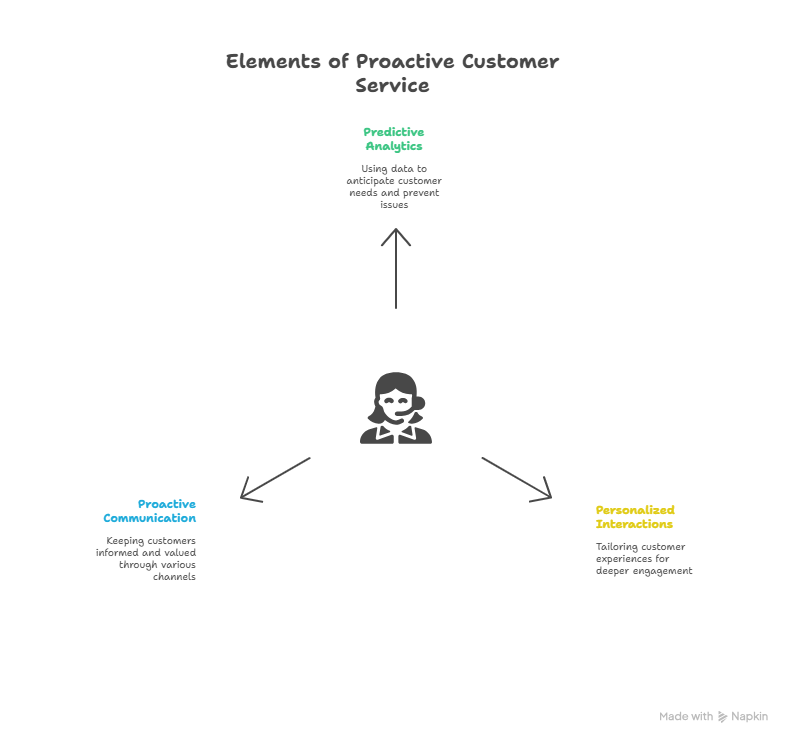Proactive Customer Service: Anticipating Needs in Advance
03 Sep 2024 By: Mary Dellosa
Updated
Nowadays helping customers just isn’t enough. Companies need to find ways to go beyond what customers expect. This is where proactive customer care service comes into play. By figuring out what customers need before they even ask, businesses can boost how happy customers are build better relationships, and in the end, grow more. In this article, we’ll take a look at what proactive customer service is all about, talk about why it matters, and check out key ways to put it into action and measure how well it’s working.

Understanding Proactive Customer Service
Before we explore why it matters, let’s clarify what proactive customer service means. This approach involves spotting and tackling customer needs and worries before they turn into problems. It’s about taking the initiative rather than just reacting. Companies don’t sit around waiting for customers to call with issues. Instead, they look for ways to predict and meet customer needs.
Customer service that stays one step ahead isn’t just about fixing problems when they pop up. It’s about stopping them before they even start. When companies look at how customers act and what they say, they can spot trouble coming and fix it before it messes up the customer’s day. This kind of thinking shows customers that the company cares about keeping them happy and wants to build a relationship that lasts.
What is Proactive Customer Service?
Customer service that gets ahead of the game is all about taking the first step to make sure customers are happy. It means being on top of things when it comes to figuring out what customers need, what they expect, and what bugs them. When businesses can guess these things before they happen, they can give quick fixes and make each customer feel special.
What’s more, customer service that stays one step ahead goes beyond just one-on-one chats to cover the whole customer journey. Companies that jump on this bandwagon don’t just fix problems as they come up. They also work to create a smooth and enjoyable experience at every step. This big-picture approach builds trust and keeps customers coming back. In the end, it boosts the company’s reputation and helps the business grow .
What are the Importance of Proactive Customer Service?
These days, customers want smooth experiences and fast answers to their questions. Customer service that gets ahead of problems has a big impact on meeting these wants. When businesses take care of customer needs before they come up, they can stop issues from getting worse and make sure customers have a good time. This forward-thinking way of doing things not makes customers happier but also boosts how much they like and talk up the brand.
Also, customer service that gets ahead of problems can set companies apart in today’s busy market. Businesses that reach out to customers first and go beyond what they expect stand out from their rivals. This forward-thinking approach not brings in new customers but also keeps current ones leading to lasting business growth and success over time.
The Shift from Reactive to Proactive Customer Service
We can’t underestimate the downsides of fixing customer problems when they happen. When companies just put out fires as they come up, they get stuck in a never-ending loop. This way of doing things often leaves customers unhappy, misses chances to do better, and makes people less likely to stick with the company.
But the customer service scene is changing, with more companies seeing the drawbacks of just reacting. They’re starting to use proactive customer support more often. It’s proving to be a better way to build strong ties with customers and make them loyal to the brand.
The Drawbacks of Reactive Customer Service
When businesses handle customer problems after they happen, they end up playing defense. They spend their time fixing issues instead of stopping them before they start. This approach leads to problems taking longer to solve unhappy customers, and people spreading negative stories about the company. In today’s crowded market, these downsides can hurt a company’s image and slow down its growth.
What’s more, taking a reactive approach often leads to a choppy customer experience. Customers might feel the company deals with their needs after a problem comes up instead of taking care of them ahead of time.
The Benefits of Proactive Customer Service
On the other hand, taking care of customers before they ask has lots of good points. When companies guess what customers want and fix it , people end up happier with the service. They stick around longer and spend more over time. This way of doing things shows customers the company cares about them doing well. It also makes the whole experience of being a customer better.
What’s more, customer service that stays ahead of the game helps businesses gain useful insights into what customers like and how they act. This allows companies to fine-tune their products and services more . When businesses reach out to customers before problems get bigger, they can build trust and stand out in a busy market.
Key Elements of Proactive Customer Service
To put proactive customer support into action, you need a well-thought-out plan. Here are some key things to think about:

Predictive Analytics in Customer Service
Using predictive analytics helps companies guess what customers want by looking at past data and trends. When businesses study how customers act, what they like, and what they’ve bought before, they can suggest personalized products and answers before customers even ask.
What’s more predictive analytics can help businesses spot possible problems before they get big letting them fix issues and make customers happier. This way of using data not makes things run smoother but also gives companies a better grasp of what customers need and how they behave.
Personalized Customer Interactions
Talking to customers on a personal level is key to customer service that stays ahead of the curve. When businesses get to know each customer’s specific wants and needs, they can adjust how they interact and what they offer. This personal touch makes the customer experience more intimate and meaningful.
Along with one-on-one interactions, businesses can also use customer grouping to aim specific messages and deals at certain groups. By splitting customers into groups based on things like age, behavior, or what they like, companies can give more relevant and interesting experiences. This, in turn, helps keep customers coming back and staying loyal.
Proactive Communication Strategies
Clear communication forms the foundation of customer service that anticipates needs. Putting into action strategies to communicate , like regular updates informative newsletters, and reaching out first, makes sure customers stay in the loop and feel appreciated. This straightforward and steady communication helps create strong bonds with customers.
What’s more proactive communication can go beyond the usual channels to include social media and chatbots. By connecting with customers where they spend most of their time, companies can offer help right away and personalized support. This makes the overall experience better for customers and encourages them to speak well of the brand.
Implementing Proactive Customer Service
Now that we get the value and key parts of proactive customer service let’s talk about how companies can put it into action:
Proactive customer service isn’t just a plan; it’s a way of thinking that should run through every part of how your business works. Past the first steps of getting and accepting its importance, the real test is in always doing it and weaving proactive methods into the fabric of your company.
Training Your Team for Proactive Service
Proactive customer service begins with your team. Training them on proactive strategies, customer empathy, and communication skills prepares your employees to anticipate and meet customer needs well. Give your team the power to own customer satisfaction.
Putting money into ongoing training and development programs keeps your team up-to-date on the newest trends and best ways to provide proactive customer service. Promoting a culture of learning in your company leads to constant improvement and new ideas in how you interact with and help your customers.
Leveraging Technology for Proactive Service
In our digital world, tech has a big impact on customer service that gets ahead of problems. Using customer relationship management (CRM) software, data analytics tools, and AI chatbots helps companies gather and study customer info, spot trends, and offer solutions before issues arise. These tools make processes smoother and let businesses respond .
Also, adding different ways to talk like social media live chat, and email to your customer service plan that stays one step ahead can boost how customers interact with you and make everything work together . By giving customers many ways to reach out, you meet what different people like and make sure they have the same good experience no matter how they contact you.
Trending Now
People’s trust in companies is going down because of data breaches and privacy issues that keep happening. This makes it essential to give customers good service before they ask for it. When you give customers good service before they need it, you figure out what they want and take care of it before problems come up. This helps to build trust, make customers more loyal, and cut down on support costs. When businesses use both proactive and reactive ways to help customers, they can make the experience more personal, efficient, and satisfying.
Some key things to do include using AI creating a big knowledge base, and getting feedback from customers to keep making service better. When businesses do these things, it makes their brand look better and helps them build relationships with customers that last a long time.
Measuring the Impact of Proactive Customer Service
To create a top-notch customer service plan, you need to assess its performance and measure its impact. Here are some crucial stats to monitor:
What are the Key Performance Indicators for Proactive Service?
Keeping an eye on things like customer satisfaction scores how fast you respond to customers, and how many customers stick around can give you some good insights into how well your proactive customer service is working. These numbers you can measure help you figure out how happy your customers are and what kind of impact it’s having on your business overall.
Customer Feedback and Proactive Service
Companies often ask customers what they think through surveys, forms, and social media. This helps businesses check how well they’re doing and make things better. When companies listen to what customers say, they can spot ways to improve their service before problems occur. It also shows customers that the company cares about getting better.
FAQs – Proactive Customer Service
What does “proactive customer service” mean?
It means anticipating customer needs and solving issues before they even ask.
Why is being proactive better than reactive?
Reacting means waiting for problems to appear. Being proactive helps prevent issues, improving customer satisfaction and loyalty.
What are key elements of proactive service?
Some core elements include predictive analytics, personalized communication, and reaching out before problems arise.
How do I put proactive service into action?
Train your team in proactive behaviors, use data tools and systems to detect patterns, and set up communication plans to reach out early.
How do I measure if it’s working?
Track metrics like customer satisfaction, response times, retention, and feedback to see if proactive efforts pay off.
Conclusion
Measuring proactive customer service isn’t just about tracking numbers. It’s also about understanding how customers feel and how much they trust your brand when you reach out before they ask for help. By listening to customer feedback and reading reviews, businesses can learn how proactive service shapes their reputation.
Looking at how these efforts affect repeat purchases, referrals, and loyalty also shows the long-term value of putting customers first. This helps companies refine their approach and build stronger relationships over time.
Want to boost your customer service and anticipate what your customers need? HelpSquad BPO offers you a team of virtual assistants and customer support pros who work round the clock to engage with your customers. Don’t just meet what customers expect—go beyond. Talk to us and turn your customer service into a dynamic force with HelpSquad BPO.
Take Customer Experience to the Next Level
Anticipate your customers’ needs and build stronger relationships with HelpSquad’s proactive customer service solutions.


